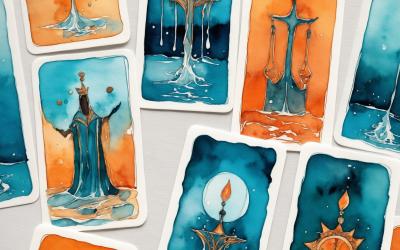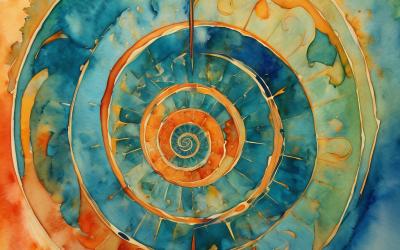Excited to do your first tarot reading but feeling a bit nervous? This guide offers practical advice and easy exercises to build your confidence. Learn how to approach tarot with curiosity and intuition, making your first reading a fun and insightful experience.
Welcome, to the threshold of your first tarot reading. If you've been following along with our previous articles, you've already explored the structure of the deck, danced with the major and minor arcana, and pondered the art of spreads and reversals. Now, you're ready to bring it all together.
You might be feeling a mix of excitement and nerves - that's perfectly natural. Remember, though, that this is just the beginning of a journey. Your first reading isn't a test or a performance; it's simply the first step on a path of discovery and self-reflection.
In this guide, we'll walk through some practical advice and exercises to help you prepare for your first reading. But remember, the key is to approach this with a spirit of curiosity and playfulness. Let's begin!
Preparation Before the Reading
Choosing the Right Deck
Selecting your first tarot deck is a bit like choosing a new book - you want something that catches your eye and piques your interest. Don't get too caught up in finding the "perfect" deck. Instead, choose one with imagery that resonates with you. It could be traditional, modern, or anything in between. The important thing is that it speaks to you.
Once you have your deck, take some time to familiarize yourself with it. Shuffle the cards, look through them, and simply get comfortable with having them in your hands.
Creating a Comfortable Space
While you don't need an elaborate setup, it's nice to have a comfortable space for your reading. This could be as simple as clearing off your kitchen table or finding a quiet corner in your living room. The goal is to have a space where you can spread out your cards and focus without distractions.
Some readers like to light a candle or play soft music to help set the mood, but this is entirely optional. The most important thing is that you feel relaxed and at ease.
Centering Yourself
Before you begin, take a few deep breaths. This isn't about entering a mystical state - it's simply about calming your mind and focusing on the present moment. If you find it helpful, you might set an intention for your reading. This could be as simple as, "I'm open to whatever insights these cards might offer."
Exercises to Build Confidence
Mindful Memory: Tarot Symbolism in Everyday Life
This exercise doesn't involve the cards directly but helps you develop your intuitive understanding of tarot symbolism. As you go about your day, pay attention to the world around you and look for connections to tarot imagery and themes.
For example:
- If you see the moon, reflect on its associations in tarot. What elements are present in the Moon card? How might its phases relate to cycles in your life?
- When you encounter a figure of authority, consider the Emperor card. How does this person embody (or differ from) the Emperor's qualities?
- If you come across a fountain or a body of water, think about the suit of Cups. How does the water's movement or stillness relate to your emotional state?
At the end of each day, spend a few minutes journaling about these observations. What tarot connections did you notice? How did viewing your experiences through this lens affect your perspective?
This practice helps internalize tarot symbolism, making it a more natural part of how you perceive and interpret the world. It also builds confidence in your ability to make meaningful connections between the cards and real-life situations.
Three-Card Spreads
One of the best ways to build confidence is through practice. Start with simple three-card spreads. These could represent past-present-future, situation-action-outcome, or any other trio of concepts that interest you.
Pull three cards and spend some time considering how they might relate to each other. What story do they seem to be telling? Don't worry about getting it "right" - the goal here is to start thinking about the cards in relation to each other and to your question.
Meditation with Cards
Choose a card that intrigues you and spend a few minutes simply observing it. What details do you notice? What feelings or thoughts does it evoke? This exercise helps you develop your own personal connections with the cards, beyond their traditional meanings.
Tips for Your First Reading
Formulating the Question
Clear questions tend to yield clearer readings. Instead of vague questions like "What will happen to me?", try more focused queries like "What should I consider as I make this career decision?" Remember, tarot is less about predicting the future and more about gaining insights into your current situation and potential paths forward.
Choosing the Spread
For your first reading, keep it simple. A three-card spread is a great place to start. You might try past-present-future, or situation-challenge-advice. The specific spread matters less than your comfort level with it.
Interpreting the Cards
As you lay out the cards, pay attention to your first impressions. What immediate thoughts or feelings come up? Trust these initial reactions - they're often where the most personal and relevant insights lie.
Then, look at how the cards relate to each other. What overall story or message seems to be emerging? Remember, there's no single "correct" interpretation. The goal is to find meaning that resonates with you and your situation.
Taking Notes
Jot down your thoughts and impressions. This can be as simple or detailed as you like. The act of writing can help clarify your thoughts, and it's interesting to look back on these notes later.
Advice for a Successful First Reading
Be Patient with Yourself
Remember, every tarot reader started exactly where you are now. It's okay if you need to refer to the guidebook or if your interpretations feel clumsy at first. Like any skill, tarot reading improves with practice.
Staying Open and Flexible
Be open to unexpected insights or interpretations. Sometimes the cards might suggest a perspective you hadn't considered. This is part of the magic of tarot - it can help us see situations from new angles.
Embrace Resources and Intuition Over Memorization
It's important to remember that at this early stage - or even as an experienced reader - it's not necessary to have every card's meaning memorized. In fact, trying to recall exact definitions can sometimes interfere with what your intuition might be telling you.
Particularly when doing readings for yourself, your initial gut feeling about a card is often the most important insight. This doesn't mean you should ignore traditional meanings entirely, but rather that you should view them as guidelines rather than rigid rules.
Don't be afraid to consult the internet, books, or other resources during and after your reading. Many experienced readers still refer to these aids regularly. Remember, the most crucial part of the reading often happens after you've put the cards away - it's the integration phase, where the meaning simmers in your subconscious and you work out what to take away from it.
So, give yourself permission to look things up, to ponder, to let meanings evolve over time. Your understanding of a reading might shift and deepen hours or even days after you've done it. This is all part of the beautiful, intuitive process of working with tarot.
What to Do After the Reading
Reflecting on the Reading
Take some time to mull over the insights from your reading. How might they apply to your life or the situation you asked about? Remember, the value of a tarot reading often becomes clearer with time and reflection.
Cleansing Your Space and Self
After a reading, it can be helpful to have a small ritual that signifies the end of the session. This doesn't have to be elaborate - it could be as simple as taking a few deep breaths, tidying up your space, or, if you enjoy it, burning some palo santo.
The purpose here isn't about mystical energy clearing, but rather about giving yourself a moment to step back into your regular mindset. It's a way of saying, "The reading is complete, and now I'm moving on with my day."
Continuing Your Tarot Journey
Keep exploring and practicing. You might join online tarot communities, read books on tarot interpretation, or practice readings for friends (with their permission, of course). Remember, tarot is a tool for self-reflection and insight - the more you use it, the more useful it becomes.
Conclusion
As you approach your first tarot reading, remember that this is just the beginning of a journey. There's no need for perfection or pressure - tarot is a tool for exploration and self-reflection, not a test to pass or fail.
Approach your readings with a spirit of curiosity and openness. Allow yourself to be surprised, to laugh, to wonder. Each card you turn over is an opportunity for new insights and perspectives.
Continue to explore, to practice, and above all, to enjoy the process. Tarot offers a rich language of symbols and archetypes that can help you navigate your inner world and your life's journey. But it's also meant to be engaging and even fun!
May your journey with tarot be filled with discovery, insight, and joy. Remember, the wisdom you seek is already within you - the cards are simply one way of accessing it.
Happy reading!






